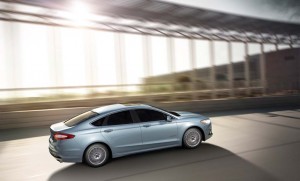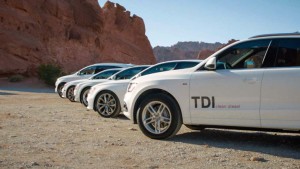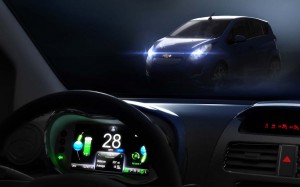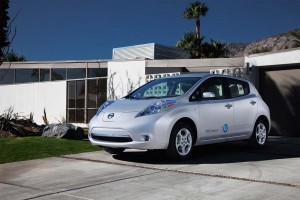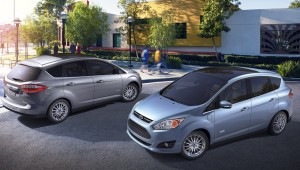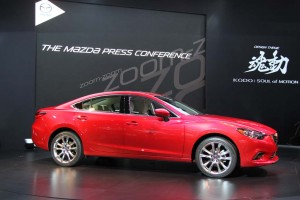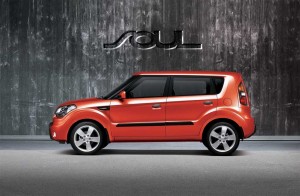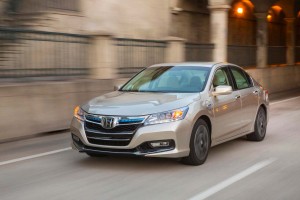
The new Honda Accord PHEV will get 115 MPGe, says the EPA, the highest mileage rating in the industry.
For years we’ve been hearing about the surprising vim and vigor of people who hit age milestones like 40 that once meant the downhill slide had begun. Now 40 is being touted as the new 30. Might this milestone hold true for cars, as well?
Is 40 miles per gallon the new 30?
Could this be the de facto standard for a new crop of vigorous, green machines that promise to cart our gracefully aging selves around while taking baby sips of fuel — or electrons?
To get a sense, we kicked the tires and listened in on the news conferences and Q&A sessions during the two press preview days at the 2012 Los Angeles Auto Show.
The second day started off with the Green Car of the Year award going to the promising new 2013 Ford Fusion that offers a hybrid version providing an average for city and highway driving of 47 mpg. Not bad.
But the Environmental Protection Agency (EPA) rates Ford’s non-hybrid version of the Fusion, utilizing a 2.5 liter, gasoline powered engine as delivering “just” 34 mpg. Which is still a big improvement from the not too distant days of yore when gas-guzzling SUVs ruled the roads and set buyers’ hearts aflutter.
Ford is also offering a Fusion with its EcoBoost option (a combination turbocharger and direct injection system) that ups fuel economy another 3 mpg to 37. Better, but it’s not 40.
Ford showed off its new Fiesta that will come with a new 1.0-liter EcoBoost engine next year. They say it will attain our 40 mpg benchmark. Ford, like the rest of the automakers will eventually have to find more ways to boost their fuel efficiency to meet the 54.5 mpg average mandated for 2025. Getting there will require some more work.
We continued our quest to find out if 40 being the new 30 analogy applies to new car mileage as well as the Baby Boom generation. One by one we asked each manufacturer how many (if any) vehicles they currently sold reached the 40 plus mpg milestone. The question was simple, but the answers weren’t always forthcoming.
Overall, the big three Japanese car companies each had good representation in the 40 mpg category with all electric (EV), hybrid (HEV) and plug-in hybrid electric vehicles (PHEV), such as Honda’s new plug-in version of its Accord boasting an MPGe of 115. That figure is reached through a rather complex calculation that equates mpg with electricity. Don’t ask.
Of the domestic brands, Ford (with its Green Car of the Year winning Fusion at 47 mpg, the new C-Max offering both hybrid and plug-in hybrid models also at 47 mpg) is making a high mileage splash.
Not to be outdone, Chevrolet wades in with the plug-in Volt (94 MPGe), and its answer to the Nissan Leaf, the all electric, subcompact Spark EV set to roll into dealerships by the Spring. These two models qualify Chevrolet for membership in the club.
Chrysler Corporation is lagging behind. Only their new turbocharged, Dodge Dart Aero attains 40 mpg on the highway but drops to the mid 30s for city and highway combined. The small car from Chrysler’s parent company, the Fiat 500 fitted with a manual transmission delivers 40 mpg on the highway but again drops down to 34 combined. But Fiat announced a new 500e, electric version, which will undoubtedly qualify for membership in the fuel sipping gang.
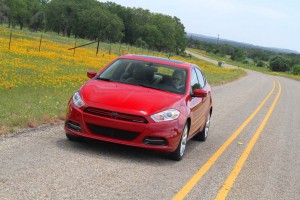
The new Dodge Dart Aero is one of the few conventionally powered vehicles to pop over the 40 mpg barrier.
Luxury and prestige brands are focused on performance, half-hearted attempts at looking green, and the exceptions, the high end offerings from two, all electric, rich boy toy companies, Tesla’s roadster and Fisker’s Karma don’t really count if you’re concerned about not melting a glacier when you put your foot in it. They just won’t sell enough of these to make a difference. But karma is karma so why not have something fun to talk about with your fellow plutocrats?
Here are some highlights of what else we learned polling the brands as we roamed the floor at the 2012 LA Auto Show.
Remember our rankings for the 40 MPG Club are estimates based on EPA listings and results may vary depending on drivers and driving conditions. I’m talking to you leadfoot. If you’d like more information and do some side-by-side comparisons, go to the EPA’s website www.fueleconomy.gov.
Nissan:
Sentra FE, Versa, and of course, the all electric Leaf at 99 mpg.
Honda:
Civic HF, Civic Hybrid, Insight, Fit EV and Accord plug ins, and the Honda Fuel Cell Vehicle all make the grade.
Toyota:
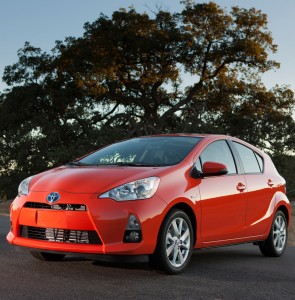
The original Toyota Prius was one of the first cars to hit 40. The "family" is growing with the likes of the new Prius V and Prius C (shown here).
Prius in all three versions (50 mpg) and the Prius plug in hybrid, Camry Hybrid, and the new Avalon Hybrid. Our correspondent thinks the Avalon in particular deserves a special accolade as it is the only full size car that currently achieves 40 plus, and is a nicely appointed near luxury vehicle priced at a bargain basement steal with dealer suggested pricing from $35,555 to $41,400, depending on the options packages.
Scion:
The offshoot brand from Toyota offers an electric version, the iQ EV that delivers 121 mpg while its non-electric cousin, the iQ come close at 37 mpg.
Hyundai:
The maker was recently forced to restate its mileage after admitting it inflated the numbers for seven models. It previously bragged about the number of 40-plus models it offered but now it admits the closest it comes is the 39 mpg Sonata Hybrid.
Kia:
Likewise, Hyundai’s sibling Korean brand rolled back mileage on six models — the Soul’s mpg cut by six — so the closest it gets is the 39 mpg Optima Hybrid. But the actor in the hamster outfit was cute and cuddly.
Mitsubishi:
The new all electric i-MIEV was given a 112 mpg rating by the EPA. As the Trojan marching band played, the company announced a pilot program giving 12 cars and some chargers to the University of Southern California (USC).
Audi:
The new A3 with a Turbo Diesel Injected (TDI) similar to its corporate stable mate VW’s Jetta TDI rings the 40 mpg bell for highway driving but not combined.
VW:
TDI versions of the Golf, Jetta Sedan, Jetta Sport Wagon, Passat, and Beetle don’t hit 40 combined, but the Jetta Hybrid clocks in with 45 mpg.
Subaru:
None, but a spokesperson complained that since all of their vehicles are 4-wheel drive they should be held to a different standard. You be the judge. Does being able to go into the back country to enjoy the splendors of the planet mean you get a fuel economy pass?
Volvo:
None, but they have a concept XC 60 plug-in hybrid coming.
BMW:
None available for sale this year. Last year the ActiveE (electric) demonstration program was launched using an electric version of its 1 Series and there are i3 and i8 concept cars. So electric cars are being actively explored by BMW. The new BMW i models, including i3 city car battery-electric vehicle will get there, and possibly the BMW i8 plug-in.
Mercedes:
None, but they have a 250 turbo diesel in the works that might make the requisite number.
Smart:
Only the all-electric version makes the grade.
Fisker:
Of course they’re in the club, since they only sell all electrics. It’s good to be green especially if you’re a member of the 1% rolling in the green.
Chevrolet:
The aforementioned Volt and the new Spark make the grade but vehicles like the Cruze Eco are turning in respectable mileage figures (42 mpg highway) with an enhanced gasoline engine.
Ford:
The Fusion hybrid and Fusion Energi plug-in, C-Max hybrid (see above) and C-Max Energi plug-in.
Mazda:
The Mazda 3 with its new Skyactiv G (for gasoline) reaches 40 mpg on the highway and the upcoming Mazda 6 with the diesel version of the Skyactiv option might get there. Mazda has made a commitment to have its lightweight, fuel efficient Skyactiv technology in 80% of its vehicles by 2016.
Lexus:
CT 200 H and the ES Hybrid.
Lincoln:
The 2013 Lincoln MKZ Hybrid will hit the 45 mpg mark — though that’s 2 mpg lower than the highway rating for the similarly sized, if less lavishly equipped Ford Fusion Hybrid.
Mitsubishi:
Only the i-Miev plug in. None of its vehicles qualify with their gasoline powered engines.
Fiat:
The base 500 with a manual transmission and the new electric 500e make it in.
Dodge:
The Dart Aero does, and of course the Charger, Challenger and the updated Viper don’t. But there is something appealing about that unrepentant male, retro muscle car styling that does trigger all those primitive impulses. Who needs mileage? Let’s burn some rubber.
Chrysler:
None. High mileage is not being “exported from Detroit.” At least from Chrysler.
Jeep:
None. Again does enjoying the wide-open spaces mean you should be given a pass on fuel economy?
Infiniti:
None, but the LE an all-electric concept is coming next year.
Aston Martin:
None, but the rep went to great pains to point out that they now offer a 4.7 liter engine option to replace the 6.0 taking their mpg from 17 to 20. Now that’s what I call green. We were somewhat shaken by these results but stirred by the movie version of the James Bond DB with the ejector seat, machine gun tail lights, and knock off hubs that shred tires, so we forgive them.
With all of the emphasis on the greening of the auto business it’s clear that 40 is still out of reach for most unless you’re willing to plunk down for a hybrid or an electric vehicle. The dismal sales so far for electrics have caused some to sour on this technology, including Sergio Marchionne, the CEO of the Fiat Chrysler Alliance, who’s called electric vehicles, “economic lemons.”
California has a long and prosperous history with real lemons and for automakers to meet the State’s stringent Zero Emissions Vehicle regulations (ZEV) they’re going to need to sell EVs in the Golden State. Which means the automakers will continue to build electrics because as John Mendel, the top American executive at American Honda, pointed out to the Detroit Bureau, “no automaker can afford not to be selling cars in California.” A fact that could give the technology time to gain mass market acceptance and the manufacturers a chance to bring down the cost.
The good news is that clean diesel (not an oxymoron like clean coal) and turbo charged, direct injected gasoline engines are getting closer to that 40 mpg number. These technologies come at a price premium but not as steep as a hybrid, plug in hybrid or an all electric. Progress is being made and the automakers are confident that they will be able to hit a corporate average 54.25 by 2025. We’ll see if by then if 55 is the new 45.

